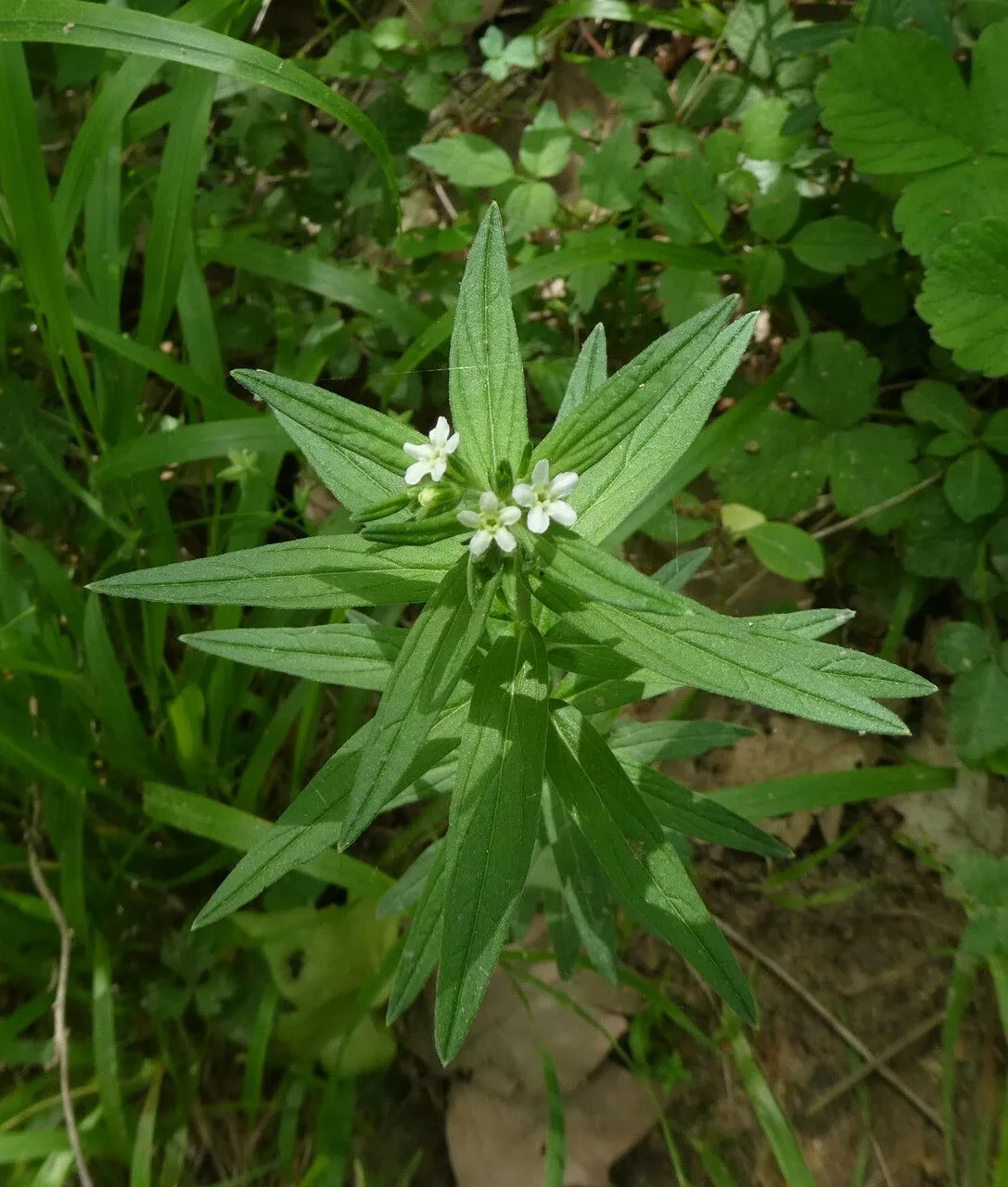
Author: L.
Bibliography: Sp. Pl.: 132 (1753)
Year: 1753
Status: accepted
Rank: species
Genus: Lithospermum
Vegetable: False
Observations: Europe to Siberia and Himalaya
Common gromwell, known scientifically as Lithospermum officinale, is a perennial herbaceous plant belonging to the Boraginaceae family. This plant is indigenous to a broad range of regions, extending from Europe to Siberia and the Himalayas. Reflecting its wide geographical distribution, common gromwell demonstrates a considerable adaptability to various environmental conditions.
The plant’s physical characteristics contribute to its distinctiveness. Common gromwell typically features rough, hairy stems supporting clusters of small, tubular flowers that exhibit a subtle yet elegant display ranging from white to pale yellow hues. Post pollination, these flowers give rise to hard, marble-like seeds, which are a notable feature of the plant, often utilized in identifying the species.
Historically, Lithospermum officinale has been recognized since the mid-18th century, with its first formal documentation appearing in the seminal botanical work “Species Plantarum” in 1753 by the renowned botanist Carl Linnaeus, who is often abbreviated as “L.” in botanical nomenclature.
The habitat preferences of common gromwell are diverse; it thrives in woodlands, pastures, and along hedge banks where it can access the full or partial sunlight it needs for optimal growth. Besides its ecological importance, this plant has also been noted for its utility in traditional medicine. Various parts of the plant have been employed historically for their purported medicinal properties, including the treatment of kidney stones and other ailments, leveraging the hardness of the seeds which were believed to symbolize and confer robust health benefits.
In summary, common gromwell is not only valued for its botanical characteristics and adaptations but also for its historical significance and traditional uses, making it a noteworthy species within the diverse family of Boraginaceae.
Dan: aksel-røn, læge-stenfrø, selje-røn
Swe: balkanoxel, bergoxel, oxel, vitoxel, rohtorusojuuri, steenfrø, stenfrö
Eng: common gromwell, european stoneseed, gromwell, pearl gromwell, european gromwell
Deu: echter steinsame, gebräuchlicher steinsame
Fin: ruotsinpihlaja, rohtorusojuuri
Nor: svensk asal, sølvasal, steenfrø
Por: aljôfar
Lav: arstniecibas cietsekle
Ita: erba-perla maggiore
Nld: glad parelzaad
Fra: grémil officinal, millet d’amour, perlière, graines de lutin, herbe aux perles
Nob: legesteinfrø
Nno: lækjesteinfrø
Spa: mijo de sol
Sme: geađgesiepman, dálkkasruohtas
Cym: grawn yr haul, gromandi, gromil, gromwel, grwmil, grwml, had y gramandi, maenhad, maenhad meddygol
Gla: gormail
Kat: კაკბის საკენკელა
En: Common gromwell, Pearl gromwell, Gromwell, European stoneseed, European gromwell
Ar: حجرية البذر المخزنية
Hy: Կաքավկրկուտ դեղատու
Az: Dərman səfərotu
Be: Верабейнік лекавы
Bg: Просо птиче
Ca: Mill del sol
Zh: Xiao hua zi cao, 小花紫草
Cs: Kamejka lékařská
Da: Læge-Stenfrø, Aksel-Røn, Selje-Røn
Nl: Glad parelzaad
Et: Suur rusujuur
Fi: Rohtorusojuuri, Ruotsinpihlaja
Fr: Perlière, Millet d’amour, Grémil officinal, Graines de lutin, Herbe aux perles
Ka: Კაკბის საკენკელა
De: Echter Steinsame, Gebräuchlicher Steinsame
Hu: Kőmagvú gyöngyköles
Ga: Gormail
It: Erba-perla maggiore, Migliarino, Miglio
Lv: Arstniecibas cietsekle
Lt: Vaistinis kietagrūdis
Se: Geađgesiepman, Dálkkasruohtas
No: Legesteinfrø, Lækjesteinfrø, Svensk asal, Sølvasal, Steenfrø
Nb: Legesteinfrø
Nn: Lækjesteinfrø
Fa: سنگدانه
Pl: Nawrot lekarski
Pt: Aljôfar
Ru: Vorobejnik lekarstvennyj, Деребянка
Gd: Gormail
Sk: Kamienka lekárska
Es: Mijo de sol, Mijo del sol, Té de perla
Sv: Stenfrö, Balkanoxel, Bergoxel, Oxel, Vitoxel, Rohtorusojuuri, Steenfrø
Cy: Maenhad, Grawn yr Haul, Gromandi, Gromil, Gromwel, Grwmil, Grwml, Had y Gramandi, Maenhad Meddygol
Taken May 23, 2018 by Pep Secem (cc-by-sa)
Taken Jun 23, 2020 by Llandrich anna (cc-by-sa)
Taken Jun 15, 2019 by Manu Pacha (cc-by-sa)
Taken May 8, 2020 by Llandrich anna (cc-by-sa)
Taken Jun 15, 2019 by Manu Pacha (cc-by-sa)
Taken May 23, 2015 by Tela Botanica − Yoan MARTIN (cc-by-sa)
Taken Oct 25, 2021 by Ornitho Galum (cc-by-sa)
Taken May 2, 2022 by Tristan Jaton-Maria (cc-by-sa)
Taken Nov 26, 2021 by Frédérique Berato (cc-by-sa)
Taken May 8, 2020 by Llandrich anna (cc-by-sa)
Taken May 2, 2022 by Tristan Jaton-Maria (cc-by-sa)
Taken Feb 21, 2020 by julien deroy (cc-by-sa)
Taken Mar 5, 2022 by lotag79 lotag79 (cc-by-sa)
Taken Jun 23, 2020 by Llandrich anna (cc-by-sa)
Taken Jun 23, 2020 by Llandrich anna (cc-by-sa)
Taken May 2, 2022 by Tristan Jaton-Maria (cc-by-sa)
Taken Nov 26, 2021 by Frédérique Berato (cc-by-sa)
Taken May 23, 2018 by Pep Secem (cc-by-sa)
Taken May 23, 2018 by Pep Secem (cc-by-sa)
Taken May 23, 2018 by Pep Secem (cc-by-sa)
Taken Feb 21, 2017 by Yoan MARTIN (cc-by-sa)
Taken Jul 21, 2011 by Tela Botanica − Liliane Roubaudi (cc-by-sa)
Taken Nov 25, 2012 by Tela Botanica − Claire SUTTER (cc-by-sa)
Taken May 23, 2015 by Tela Botanica − Yoan MARTIN (cc-by-sa)
Taken Nov 1, 2015 by Tela Botanica − Pierre PIVETEAU (cc-by-sa)
Taken Aug 13, 2018 by Catherine Bouvard (cc-by-sa)
Taken May 23, 2008 by Tela Botanica − Mathieu MENAND (cc-by-sa)
Taken Aug 23, 2021 by Bénard Tremblay Milo (cc-by-sa)
Taken Sep 3, 2018 by jeclerencia (cc-by-sa)
Taken Aug 23, 2022 by Perrine M (cc-by-sa)
© copyright of the Board of Trustees of the Royal Botanic Gardens, Kew.
© copyright of the Board of Trustees of the Royal Botanic Gardens, Kew.
© copyright of the Board of Trustees of the Royal Botanic Gardens, Kew.
Growth habit: Forb/herb
Ph maximum: 8.0
Ph minimum: 7.5
Light: 7
Atmospheric humidity: 4
Bloom months: [‘may’, ‘jun’, ‘jul’]
Soil nutriments: 4
Family: Myrtaceae Author: (F.Muell.) K.D.Hill & L.A.S.Johnson Bibliography: Telopea 6: 402 (1995) Year: 1995 Status:…
Family: Rubiaceae Author: Pierre ex A.Froehner Bibliography: Notizbl. Bot. Gart. Berlin-Dahlem 1: 237 (1897) Year:…
Family: Sapindaceae Author: Koidz. Bibliography: J. Coll. Sci. Imp. Univ. Tokyo 32(1): 38 (1911) Year:…
Family: Asteraceae Author: A.Gray Bibliography: Pacif. Railr. Rep.: 107 (1857) Year: 1857 Status: accepted Rank:…
Family: Fabaceae Author: Medik. Bibliography: Vorles. Churpfälz. Phys.-Ökon. Ges. 2: 398 (1787) Year: 1787 Status:…
Family: Aspleniaceae Author: (Cav.) Alston Bibliography: Bull. Misc. Inform. Kew 1932: 309 (1932) Year: 1932…